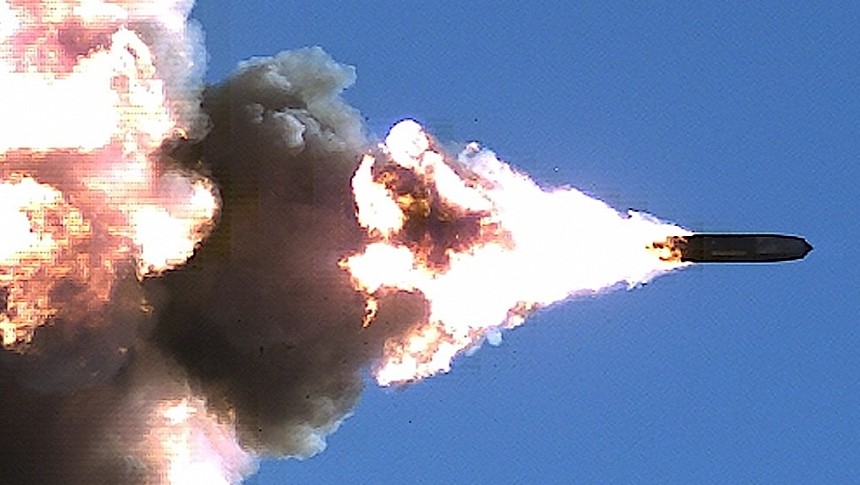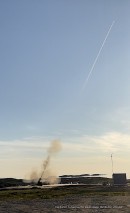Historically speaking artillery rounds have always been dumb pieces of ammunition, simple to make and fire, and devastating in their effects. All one needed to do was fill a shell with explosives, stick it into a large gun, and fire it. But not any more.
As counter-artillery means have evolved, the world's militaries had to devise ways for shells to get smarter and deadlier. That's how we now have both powered and guided artillery rounds being used in conflicts around the world. And more are being developed.
Back in 2019, a Norwegian/Finnish company called Nordic Ammunition Company (Nammo) began working on a way to integrate ramjet means of propulsion into artillery rounds. The project quickly caught the attention of the U.S. Army and Boeing, both of which jumped on board for the project.
In the summer of last year we witnessed the most recent firing of the projectile. Called Boeing Ramjet 155 Extended Range Artillery Projectile (or Ramjet 155 for short), it was released from a 39-caliber towed artillery cannon over in Norway. The weapon immediately proved its merits, igniting its engine and following a stable path to its target. It was the "longest-ever indirect fire test of a Ramjet 155 munition" recorded to that time, even if the exact distances involved were not announced.
Whatever that record was, it was broken last week at the Yuma Proving Ground in Arizona. There, the Ramjet 155 was fired from a 58-caliber Extended Range Cannon Artillery (ERCA), managing to outdo itself once more.
But how does the projectile work? Well, the thing is fitted with an air-breathing engine that uses the cannon firing to get to the speed it needs to ignite. The power the thing can provide to itself can help it reach incredible speeds and ranges.
These are numbers kept secret for this weapon, but we do know a typical ramjet device can reach speeds of up to Mach 3 (2,300 mph/3,700 kph). The presumed range of the Ramjet 155 is about 40 km (25 miles), which is more than double that of existing projectiles.
The most recent firing of the thing over in America was meant to prove it can be fired from the ERCA, but also to validate performance. The parties involved say both objectives were met, and that the project will move forward.
Boeing and Nammo now plan to give the 155 a sort of brain, and upcoming tests will see it being fitted with the guidance system used on Joint Direct Attack Munition (JDAM) weapons. The future tests will see the ramjet being fired at both stationary and moving targets.
None of the parties involved said anything about when the world should expect the Ramjet 155 to be ready for battlefield use in the real world.
Back in 2019, a Norwegian/Finnish company called Nordic Ammunition Company (Nammo) began working on a way to integrate ramjet means of propulsion into artillery rounds. The project quickly caught the attention of the U.S. Army and Boeing, both of which jumped on board for the project.
In the summer of last year we witnessed the most recent firing of the projectile. Called Boeing Ramjet 155 Extended Range Artillery Projectile (or Ramjet 155 for short), it was released from a 39-caliber towed artillery cannon over in Norway. The weapon immediately proved its merits, igniting its engine and following a stable path to its target. It was the "longest-ever indirect fire test of a Ramjet 155 munition" recorded to that time, even if the exact distances involved were not announced.
Whatever that record was, it was broken last week at the Yuma Proving Ground in Arizona. There, the Ramjet 155 was fired from a 58-caliber Extended Range Cannon Artillery (ERCA), managing to outdo itself once more.
But how does the projectile work? Well, the thing is fitted with an air-breathing engine that uses the cannon firing to get to the speed it needs to ignite. The power the thing can provide to itself can help it reach incredible speeds and ranges.
These are numbers kept secret for this weapon, but we do know a typical ramjet device can reach speeds of up to Mach 3 (2,300 mph/3,700 kph). The presumed range of the Ramjet 155 is about 40 km (25 miles), which is more than double that of existing projectiles.
The most recent firing of the thing over in America was meant to prove it can be fired from the ERCA, but also to validate performance. The parties involved say both objectives were met, and that the project will move forward.
Boeing and Nammo now plan to give the 155 a sort of brain, and upcoming tests will see it being fitted with the guidance system used on Joint Direct Attack Munition (JDAM) weapons. The future tests will see the ramjet being fired at both stationary and moving targets.
None of the parties involved said anything about when the world should expect the Ramjet 155 to be ready for battlefield use in the real world.








